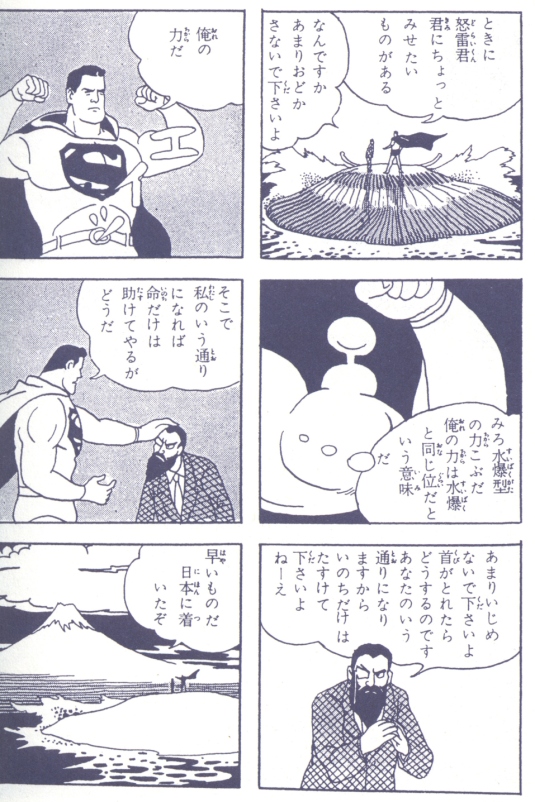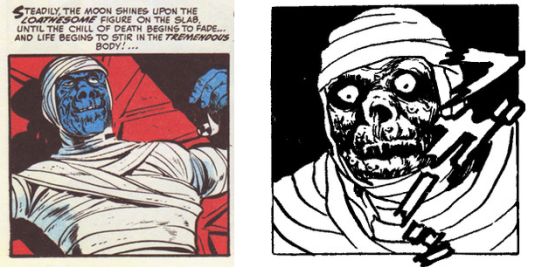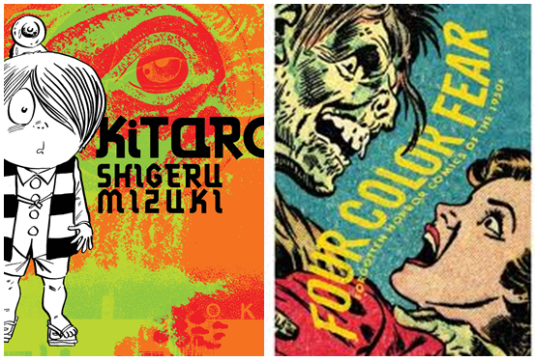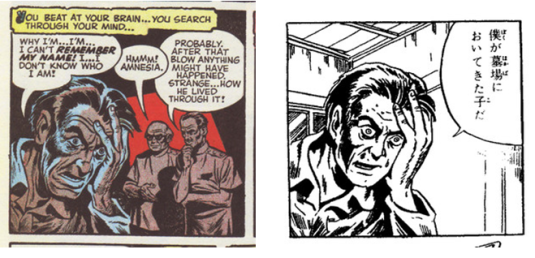When you think of influences on Japanese comic book legend Mizuki Shigeru, names like Basil Wolverton, Bob Powell, and Warren Kremmer don’t usually spring to mind. After all, those artists drew for 1950s American horror comics like Tomb of Terror and Crypt of Horror. They hardly seem like source material for a young man thousands of miles across the ocean. Where would he find them? And if he did find them, how could he read them?
But the influence is obvious. Mizuki Shigeru’s early work has the same shadowy gloom, the same lines and dramatic poses. This is especially true in Mizuki’s comic Hakuba Kitaro (Graveyard Kitaro), his darker, more horrific version of his famous character Kitaro before it was lightened and made more child-friendly at the publisher’s request. The opening story in Hakuba Kitaro—called Kitaro no Tanjobi or Kitaro’s Birthday—in particular looks and feels like a 1950s EC comic. If it weren’t for the Japanese lettering and some of the faces, Kitaro no Tanjobi could easily have risen from Tales from the Crypt or Vault of Horrors.
Mizuki has never been shy about these influences. He is widely read, and was fascinated with American and European authors and philosophers. He borrowed freely for his comics, adapting obscure horror authors like W. F. Harvey, whose 1928 story The Beast with Five Fingers was transformed into the Kitaro adventure The Hand. (See Kitaro and the Beast with Five Fingers.)
In his historical/auto-biographical comic Showa: A History of Japan Mizuki describes how American comics came into his hands. In the post-war period, Mizuki’s father had a position working with the occupation government. Mizuki’s father spoke English and even worked as an English teacher, which made him a valuable bridge between the occupiers and the native Japanese. Mizuki’s father knew his son was struggling, trying to break into the fledgling kashihon rental-comic market after his former kamishibai (paper theater) business had vanished. He brought home the various comic books left behind by American GIs and civilians working in the occupational government, and gave them to his son to use as reference material and inspiration for his own comics.
It is pretty obvious which American comic inspired Mizuki’s first hit with the kashihon rental-comic market. Although he called his version Rocketman, Mizuki made no attempt to disguise the character’s origin, and didn’t even bother to alter the famous “S”-shield on the chest into an “R”—which would have been more appropriate for “Rocketman.” Mizuki may have taken the look of Superman directly from the comic, but he told it with his own sense of whimsy and style. It almost looks like he is imitating the Fleisher Brothers’ Popeye cartoons instead of Superman, as Rocketman flexes a muscle in the shape of an atomic bomb’s mushroom cloud to show off just how mighty he is.
 So the influence was always there. But it wasn’t until the publication of Fantagraphics’ Four Color Fear: Forgotten Horror Comics of the 1950s
So the influence was always there. But it wasn’t until the publication of Fantagraphics’ Four Color Fear: Forgotten Horror Comics of the 1950s that it became clear just how much of an influence there was. (Or at least until a copy of that book found its way into the hands of Natsume Fusanosuke who wrote the initial blog that inspired this post.
In the time-honored tradition of comic artists, it looks like Mizuki Shigeru may have had his own “swipe file” of poses and characters that came straight from American comic book artists.
These first images come from the 1959 kashihon comic Yokaiden by Mizuki Shigeru. There can be no mistake that Mizuki took several of the poses and faces directly from Warren Kremmer’s 1953 comic Amnesia. The poses are identical, even though they are being used for different story elements.
The biggest surprise—and “Ah ha!” moment—comes when looking at Kitaro’s father. The mummy in these pictures is Kitaro’s father, before he liquefies and renders into the famous version of Medama Oyaji that we all know and love. I always thought this was a weird design for Mizuki. Mummies aren’t exactly prominent in Japanese folklore and horror, and it never really made sense that Mizuki would chose a shambling mummy to represent the last of the Yurei Zoku, the Ghost Tribe, that once ruled over the earth.
 But here, in Bob Powell’s 1951 comic Servants of the Tomb we see the origin and inspiration of Kitaro’s father. This one isn’t a direct swipe like the others, but it is obvious that Mizuki Shigeru saw this comic and thought enough of the monster to use it for the brief appearance of Kitaro’s father as a whole creature. Finally, the design makes sense.
But here, in Bob Powell’s 1951 comic Servants of the Tomb we see the origin and inspiration of Kitaro’s father. This one isn’t a direct swipe like the others, but it is obvious that Mizuki Shigeru saw this comic and thought enough of the monster to use it for the brief appearance of Kitaro’s father as a whole creature. Finally, the design makes sense.
Bob Powell and Warren Kremmer are in good company. Mizuki Shigeru also collects early European prints by artists like Albrecht Dürer, and uses them for inspiration. I have seen several posts by Mizuki where he shows the original, and his version next to it. He also copies the work of Japanese masters like Toriyama Sekein and Katsushika Hokusai for his Yokai Encyclopedias and print series, and uses famous photographs and historical works of art to ground his series like Showa: A History of Japan.
As Natsume mentions in his article, there are probably more of these swipes from early comics to be discovered by someone with the patience and means to find them. Natsume further speculates that, if American GIs carried American comics with them to Japan and inspired a young Mizuki Shigeru, perhaps they brought them to Europe and influenced a certain young man who would come to be known as the artist Moebius.
Who knows? But American comic art traveled far, and the American GIs served as unknowing Johnny Appleseeds, leaving behind their discarded bits of Americana and pop culture that got absorbed and assimilated into something else, something that has become a foundational element of Japanese culture.
Further Reading:
For more about Mizuki Shigeru, check out:
6 Types of Japanese Yokai From Showa
Countdown to Mizuki Shigeru’s Showa 1926-1939: A History of Japan





May 03, 2014 @ 06:19:04
Just looking at my signed copy of “Tales of Shigeru Mizuki” I got when I met him at an early anime convention back in the 1990s. It’s a nice work and in English (says one of 300). I had been watching “Ge Ge Ge no Kitaro” from Hawaiian TV at the time so when Mizuki asked me what character I wanted him to draw of course I said “Nezumi Otoko”! This seemed to shock the hell out of him that someone actually knew of him there (the only other people who recognized him were Japanese guests of the con) and knew of his work. This impressed him so much that I got a couple sketches and his signature on the book which is one of my prized possessions. I’m heading out to pick up a copy of his work for Free Comic Book Day. Odd that they picked some of his newer work though considering that FCBD is mostly about getting kids to read and so, Kitaro would have been the obvious choice. Ah well, I’m glad to have met him in person, however briefly all those years ago…
May 03, 2014 @ 11:57:53
Excuse me being so bold, but would you happen to know the name of the publisher requesting the dark kitaro be altered?
i’ve encountered this statement lots of times but never were there any details.
It’s especially confusing since i found out the darker version of Kitaro was continued by somebody named takeuchi Kanko and the two versions ran (what i assume to be) simultaniously
the existence of this second kitaro makes it (to me) kind of difficult to get a true big picture of the evolution of Kitaro as a series
May 03, 2014 @ 22:42:00
Any idea if Mr. Mizuki adapted any of Manly Wade Wellman’s work? Seems to have a lot in common since those works delve into a lot of back woods people and folklore. I really like the “Silver John” stories best of Wellman’s work but also some of his work that was adapted to TV like “Still Valley” in The Twilight Zone…
Jan 15, 2015 @ 11:27:20
Reblogged this on The Horrifically Horrifying Horror Blog.